 |
Figure 2 | DIP-V-15100 photomicrographs. Overview of dorsal wing surface, with claws.
DOI: 10.1038/ncomms12089 |
The mid-Cretaceous Burmese amber deposit of northeastern Myanmar is one of the most prolific and well-studied sources of exceptionally preserved Mesozoic arthropod and plant fossils, but work on feathers from this deposit has just begun. Previous studies of plumage in Cretaceous amber have been based on isolated feathers, leaving taxonomy of the feather-bearers open to debate, and amber in vertebrate bone beds has seldom yielded fossils. Otherwise, Cretaceous feathers are commonly known from carbonaceous compression fossils, and three-dimensional preservation in amber is extremely rare. The combined fossil record of amber and compression fossils has provided many insights into how the feather types associated with modern birds developed, but these glimpses are restricted by preservation in each fossil type. The discovery of two partial bird wings in Burmese amber unites taxonomic and ontogenetic information from osteology with microscopic preservation down to the level of individual feather barbules and their pigment distributions. This new source of information includes integumentary features incompletely known in the compression fossil record.
The studied specimens come from the Angbamo site, Tanai Township, Myitkyina District, Kachin Province of Myanmar. A combination of biostratigraphy and radiometric dating have established an age estimate of 98.8±0.6 Ma for this deposit. The two partial wings (DIP-V-15100 and DIP-V-15101) are tiny, and are preserved within a few cubic centimeters of amber. They were examined by combining synchrotron X-ray micro-CT data for osteology, with standard macro- and microscopic observations of integumentary structures. The small size and poorly-defined articular facets indicate that both specimens were juveniles at the time of death. Although the specimens are similar in gross morphology, proportions and some plumage characteristics, their immaturity limits detailed comparisons. We tentatively suggest that the specimens belong to the same species, and suggest that the following anatomical description should be treated with some caution, given the potential for large-scale ontogenetic changes.
.............
 |
| Figure 1: SR X-ray μCT reconstructions of osteology in DIP-V-15100 and DIP-V-15101. (a) Mummified DIP-V-15100, showing rachises, skin, muscle and claws. (b) Skeletal morphology of DIP-V-15100, using different density threshold. (c) Mummified DIP-V-15101, showing rachises, skin, muscle and claws. (d) Skeletal morphology of DIP-V-15101. (e) Reconstruction of osteology based on the CT data.
al, alular digit; am, alular metacarpal; ma, major digit; mam, major metacarpal; mi, minor digit; mim, minor metacarpal; ra, radius; ul, ulna. Scale bars, 5 mm. DOI: 10.1038/ncomms12089
|
Lida Xing, Ryan C. McKellar, Min Wang, Ming Bai, Jingmai K. O’Connor, Michael J. Benton, Jianping Zhang, Yan Wang, Kuowei Tseng, Martin G. Lockley, Gang Li, Weiwei Zhang and Xing Xu. 2016. Mummified precocial bird wings in mid-Cretaceous Burmese amber. Nature Communications. 7, 12089. DOI: 10.1038/ncomms12089
Mummified, 99-Million-Year-Old Wings Caught in Amber https://shar.es/1loySs via @LiveScience
Frozen in amber: bird wings from Age of Dinosaurs http://www.cbc.ca/1.3655942
Rare Dinosaur-Era Bird Wings Found Trapped in Amber @NatGeo



